Samsung LN-T5281F LCD 1080p HDTV Measurements
Summary
• The Samsung provides excellent resolution in HDMI, particularly with 1080i in the Just Scan aspect ratio setting. Component HD resolution, however, was less impressive.
• The set's color performance was much better than average out of the box—in Warm2 and the Auto setting of the Color Space Control—but a good calibration is recommended for best performance.
• The peak contrast was stunning, thanks to a sometimes-unmeasurable black level. The ANSI contrast was also among the best we've measured.
Details
Settings
In the past we've been reluctant to provide the precise settings we have determined to produce the best image. There are good reasons for such reluctance. But readers have been asking for it, so this information is shown here.
Keep in mind, however, that unit-to-unit sample variations, the viewing environment, and the source might render these recommendations less than optimum. So we strongly recommend that you confirm the results on your sample by using one of the many display setup DVDs that are available. This will help you to set up the user video controls correctly, and get as close as possible to an optimum picture short of a full calibration. The latter is best left to a trained and properly equipped technician, such as those trained and certified by the Imaging Science Foundation (ISF).
In my case, all of the settings shown here were obtained in as dark a room as I could manage. A darkened room—variations in wall reflections aside—is as close as we can come to an environment the reader can duplicate. In the case of the Samsung, if you find a need for a brighter image with the room lights on, I suggest that you start by first increasing the backlight control.
Mode: Movie
Contrast: 90
Brightness: 46
Sharpness: 25
Color: 50
Tint: R56/G44
Backlight: 3
Color Tone: Warm2
Size: Just Scan (16:9 for 480i and 480p sources)
Digital NR: Off
Active Color and DNIe: N/A in Movie Mode
LED SmartLighting: On
Detailed Settings
Black Adjust: Off
Dynamic Contrast: Off
Gamma: -1 to +1 0 (see text)
Color Space: Auto
White Balance:
Offset - R17, G16, B15
Gain - R14, G12, B12
My Color Control: All 15 (centered)
Edge Enhancement: Off
xvYCC: Off
LED Motion Plus: Off
Film Mode: On
Energy Saving: Low
HDMI Black Level: Normal
Fade to Black
I found that even an increase of a single step on the brightness setting shown above could raise the black level enough to make the screen visible on a video black image even in a darkened room, though just barely.
And you might find, as I did, that you will get this slightly lighter video black when you set up the black (brightness) level using the PLUGE with gray scale pattern (such as on Digital Video Essentials chapter 12-2) that most of us use for black level setup. I had to use a PLUGE with a 5% gray window (from the 1280x720 section on the Digital Video Essentials HD DVD) to get the complete fade-to-black result described in the review. That's the setting shown above.
Which is correct? That's a philosophical discussion for another time, but I would argue, at least for now, that a setting made by using the PLUGE with 5% window pattern may be more effective for very dark scenes.
All of this, of course, assumes that you're using the picture settings shown above, and in particular that you avoid the black level "enhancements" offered in the menus.
Resolution
With a 1080i HDMI input and the aspect ratio set to Just Scan, the sharpness test pattern was flawless, with a crisply-defined, 1-pixel width line. No edge enhancement was visible at any setting of the Sharpness control (the control position shown in "Settings" above was my first, pre-setup best estimate, and though moving it produced no visible change one way or another, I left it there). The luminance multiburst at the maximum 37.1MHz was also beyond criticism, and the color burst very nearly as good.
At 720p HDMI, in Just Scan, the results were nearly as good as with 1080i, with only a small rolloff visible in the maximum frequency luma and color burst. The results at both 480i and 480p were good for those formats.
The component results were a significant step down from HDMI. In 1080i, the luma resolution was gone by 37.1MHz. At 720p, the resolution was a bit better than that, though satisfactory. The 480i/p results were also satisfactory. HDMI is definitely the preferred connection for this set.
Color
In theWarm2 color temperature setting, the Samsung's pre-calibration color temperature was good but a little higher than the desired 6500K through much of the brightness range (Fig.1). Calibration brought this closer (Fig.2). It might be argued that both results are slightly compromised based on the numbers alone, but Figs.3 and 4 show that the color balance was significantly better after calibration. Out of the box (Fig.3), the set was minus red across the full brightness range with respect to the D6500 standard. Ideally, red, green, and blue should all overalap in a single horizontal line at the center of this chart. The larger, post-calibration result in Fig.4 shows a much better match.
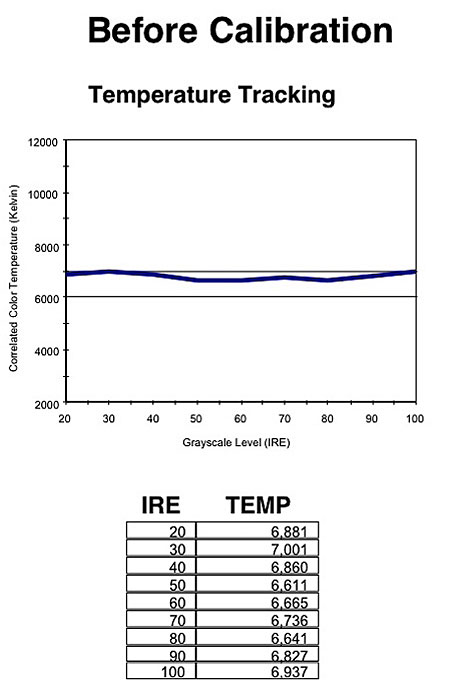
Fig.1
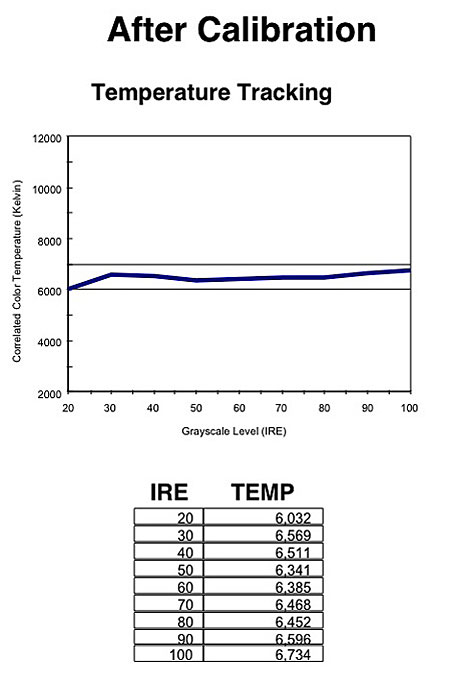
Fig.2
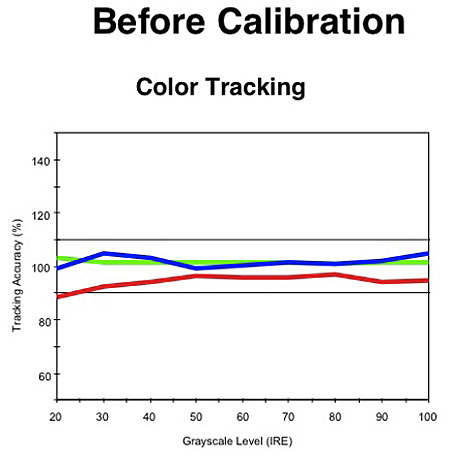
Fig.3
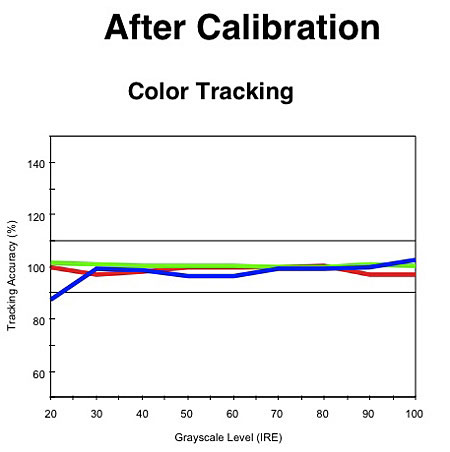
Fig.4
The primary red and blue color points on the Samsung were exceptionally close to the correct values with the Color Space set to Auto (Fig.5). (The white triangle outlines the Samsung's color space, with the primaries at the peaks of the triangle; the black triangle encloses the standard REC 709 color space.)
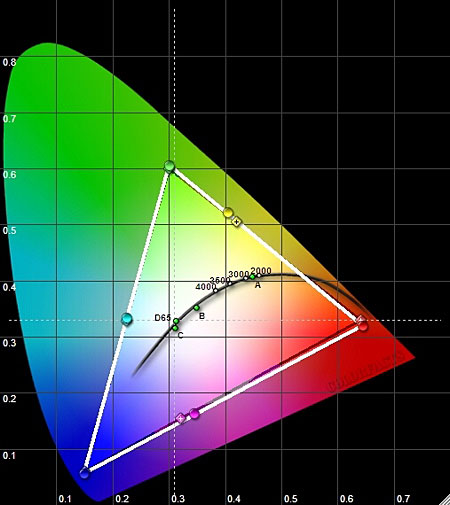
Fig.5
Contrast and Overscan
Measuring the peak contrast ratio of the Samsung proved challenging. When set up so that the LED backlights shut off with a full screen, video black image, the light output was 0.00. With 0.00 in the denominator, you get an infinite peak contrast ratio. But that is not a reasonable result. To get any number at all, I used 0.001 as the black level (the lowest number that my Minolta light meter will read!). Using that technique, the peak contrast ratio measured 46,000:1 (46 foot-Lamberts peak white, 0.001fL video black)!
That isn't really a very meaningful figure. And while I don't know how Samsung arrived at its spec of 500,000:1 (!), the peak contrast ratio of this set is still very impressive, whatever the number.
The ANSI contrast ratio measurements produced a more realistic result. Using a 16 square checkerboard pattern of alternating white and black squares, I measured an impressive ANSI contrast ratio of 2,340:1 (38.84fl white, 0.0166fL black)
Overscan in both component and HDMI averaged under 0.5% in 720p and 1080i with the aspect ratio set to Just Scan, and between 3% and 3.5% in 480i/p. I suspect the 0.5% readings were the result of masking by the screen frame rather than a circuit design limitation.




























































